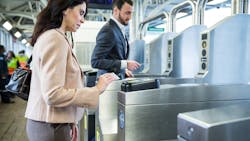How fare capping, contactless payments and cash load at retail are enhancing financial inclusion within public transit
Fare capping has attracted national attention since its launch in Portland as a way to increase social equity in public transit. As more transit agencies consider implementing fare capping to reduce cost barriers and increase ridership, they should evaluate additional ways to strengthen financial inclusion and accessibility.
Financial inclusion is a critical component of social equity and it centers on ensuring individuals have easy and affordable access to financial tools and services. Transit agencies have a significant impact on this measure of public wellbeing; after all, transportation is the gateway for individuals to hold a job and improve their financial standing. It can also be a considerable expense for those who cannot afford frequent rider passes and the discounts that come with them. Fare capping improves the accessibility of such discounts to all riders, making the policy a strong tool for improving financial inclusion.
Fare capping is just one way transit agencies can improve their accessibility as they consider how riders pay fares and manage their budgets. With technological advances in contactless payments and cash loading at retail, agencies can enhance social equity like never before.
Fare capping, contactless payments and cash loads at retail address different issues related to the fares riders must pay and the methods they use to pay for public transportation. Together, they can serve as complementary tools for transit agencies to expand ridership while limiting the time and monetary costs associated with fare collection.
Here is a snapshot of these innovations and their collective potential to support social equity in transportation.
Fare Capping’s Reduction of Cost Barriers
Fare capping ensures all passengers can access the best fares by reducing the costs of paying upfront for discount passes. Consider a hypothetical transit system where a one-way ticket costs $2.50 per ride and a 30-Day Pass costs $95 for unlimited rides over the course of a month. Despite the long-term savings of the 30-Day Pass, not every rider can afford to pay that higher upfront cost. A rider with a low income may instead have to pay the standard $2.50 fare every time they ride. If they take the train twice a day for their commute, that fare adds up to $150 after 30 days – a significantly higher amount than the $95 cost of a 30-Day Pass.
Fare capping reduces this cost barrier by ensuring all riders who meet the monthly ride criteria can access that long-term discount, regardless of whether they pay upfront or per ride. For example, a rider could purchase a reloadable fare card and load $2.50 to their account each time they want to ride. If the rider pays $95 for fares within 30 days, they will not pay for additional trips until that 30-day period is over.
Markets that have implemented fare capping are positioning themselves to attract more riders and provide more accessible options for consumers across the financial spectrum. The potential of this system led New York City’s Metropolitan Transportation Agency (MTA) to launch a four-month long fare-capping pilot program in February 2022. If successful, fare capping may become permanent in the country’s largest public transit authority.
While this is the latest trend capturing the attention of transit agencies, it is not the only upgrade drawing in more riders. Contactless payments have also emerged as an option to reduce operational expenses and create a more convenient rider experience.
Tap and Go Payments Gain Popularity
Contactless payments eliminate physical contact between a payer and the point of sale (POS). Common applications include smart cards that enable consumers to pay for items simply by tapping a POS terminal. Other setups may allow them to access a mobile wallet or payment app on their smartphone and holding it near the terminal. Contactless payments expand the options available to consumers to manage their money and support greater financial inclusion for those seeking to participate in today’s increasingly digital economy.
In the transit industry, contactless payments arrived in the form of “tap and go” transactions, which enable riders to pay their fare by tapping their smartphone or an account-based smart card on a validator or kiosk rather than tendering cash or single-use tickets. The setup reduces wait times for riders entering train stations or boarding buses. It has also empowered transit authorities to transition to cashless systems.
Eliminating cash payments can help maximize the benefits of tap and go payments, from lowering operational costs to reducing boarding times for riders. However, it is important to ensure cashless systems do not exclude cash-preferred consumers from riding. Regulations such as Title VI of the U.S. Civil Rights Act require public agencies to accommodate low-income individuals and those who prefer to use cash.
One route that agencies have explored to avoid excluding any segment of their rider base is offering the option to load transit accounts with cash at retail locations.
Loading Transit Accounts with Cash at Retail
A reliable technology partner can make all the difference in maintaining a cashless transit system that does not sacrifice accessibility. For instance, by leveraging a retail network that has hundreds to thousands of points of distribution, cash-preferred consumers are no longer limited to station infrastructure, such as customer service desks, kiosks or ticket vending machine (TVM) as the only options to manage account funds.
One way this arrangement can work is by having a rider reload their account at the store’s POS system. The consumer tenders the cash they want uploaded to their account, then the store’s POS system processes the transaction with the transit agency to update the rider’s account appropriately. Next time the rider boards a vehicle, they can tap their transit card at the train station or on the bus validator to pay their fare in a contactless manner.
Offering cash loads at retail is an effective way to remove another undue burden from riders – the time and cost of traveling to stations to manage their account funds. Rather than a narrow pool of payment kiosks and customer service desks, riders have access to a greater range of options to manage their accounts at stores conveniently located within their neighborhoods.
With the right support, transit agencies can streamline the transition to contactless payments while also ensuring cash-preferred consumers can continue to ride. When combined with fare-capping, contactless payments and cash loads at retail can improve a transit authority’s ability to provide accessible riding experiences and promote financial inclusion and social equity.
Complementary Approaches to Accessible Transit
Transit agencies are at a crossroads as they consider the best policies and technology to accommodate more riders while lowering operational costs. Introducing tap and go payments can help agencies reduce the cost of maintaining the infrastructure needed to process cash for fare payments, while also reducing wait times for riders. To maintain accessibility and financial inclusion, agencies should consider partnering with a technology provider to enable cash load at retail, as well as adopting fare capping to accommodate low-income riders. These may be separate processes, but together they can support more accessible (and equitable) transit systems.
-----------------
Michael Herold is vice president of business development at InComm Payments.
About the Author

Michael Herold
vice president of Business Development for Tolling & Transit, InComm Payments
Michael Herold is vice president of Business Development for Tolling & Transit at InComm Payments, a global leader in innovative payments technology. In his 12 years with the company, Herold has focused on developing products, solutions and partnerships that drive a seamless payments experience for cash-preferred consumers in the public transportation and tolling industries.
